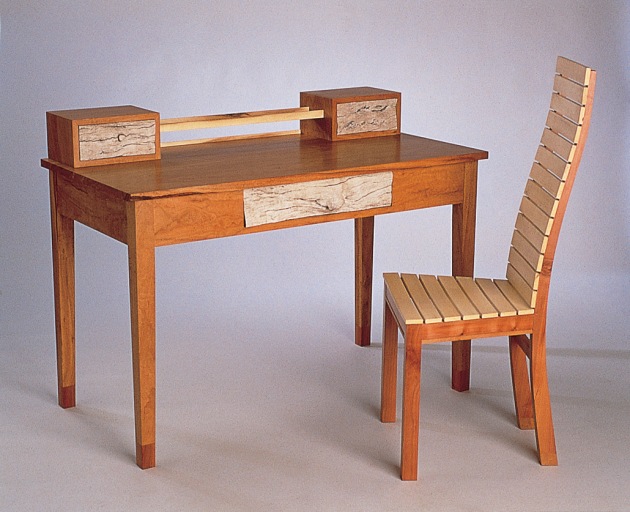Looking back: Andrew Wood's Reading the Country exhibition
Above: Andrew Wood's Woodland desk and chair, yellow box, wild cherry, sweet bursaria
Words: Hamish Hill
Photos: Paul Scott
Reading The Country was an exhibition of furniture designed and constructed by Andrew Wood which was displayed at Craft Victoria Gallery June 1–July 1, 2000.
Andrew truly knows the trees from the wood, as well as the wood from the trees. He is very obviously a man who cares for the forest that produces the timber, just as much as he does for the timber itself, and is quite obsessively concerned for both. His background in architecture, landscape and design is also quite apparent in this, his first solo show.

Insect Box, redgum and silver wattle
This exhibition consists of nine pieces of furniture, each one constructed of particular Victorian timbers representing specific parts of the Victorian bush, tracing the trees from the mountains to the sea. The title of each piece also has a relationship to either the specific area of growth or sometimes to a particular feature in the materials used.
The catalogue contains information concerning the materials used and the forces at play in the creation of timber. These forces range from the ravages of fire to the destruction of floods and even to the secretions of wasps—these and many other things form the materials Andrew is working with.

Lightning tables, redgum
The joinery techniques used demonstrate a good understanding of traditional methods, however a creativity and simplicity in the use of non-traditional techniques is also exhibited. All in all there is a sound understanding of structure.
Discussing specific pieces in any detail is particularly difficult, as there is a danger of doing a disservice to those not discussed. Regardless of this I think ‘Insect box’ made of redgum, deserves extra comment. Andrew’s notes say: ‘Plants and insects exist in close, sometimes symbiotic relationships. Insects aid pollination and break down organic material; plants provide food and habitat. In the case of the bleached grey, moon landscape of the wood in this piece, the insect secretes plant hormones into the tree, which change the cell structure to create a home for larvae. This event might have occurred only once but the resulting dramatic cellular change continues through the life of the tree.’

River Yarra cabinet in manna gum, silver wattle and bottle brush alongside a Yarra River view.
The very prickly appearance of the beautifully weathered timber panels of this box discourages the viewer from attempting to touch them, however if you know which two panels to press and do so firmly, the top of the box rises up out of the frame and is easily removed. This ingenious opening device conceals a very handy and safe container for any special valuables. It operates simply, using two 45° chamfers on both the underside of the heavy lid and the inside of the sliding sides, hard to describe and probably to make, but beautifully simple to operate.

Ash shelving, shown with the mountain ash and blackwood forest which inspired it.
One of the great pleasures of this exhibition for me was to see the strong professionalism displayed by Andrew in both the designing and making of the furniture and the planning, designing and organising of the exhibition.

Paperbark Forest screen, melaleuca and kauri shown with the environment the timber grows in.
The works are well placed around the gallery, with small photographs of the forests from where the timbers came carefully attached to the wall. These photographs are placed in a position and at a height pertinent to the piece of furniture and to the type of forest. The catalogue is an excellently produced and packaged set of cards. Each card shows one, well photographed piece of furniture superimposed over the type of forest from which the timber came. Then on the back of each card is a brief description of the timber used and its natural environment.

Billabong table in redgum and kauri alongside a river redgum scene.
The great frustration I have after viewing this exhibition is the thought that unless some generous benefactor appears out of the blue, this exhibition, like so many others, will run for one month only and then disappear. So few people will have had the opportunity to enjoy it! I feel it is a shame that a show like this can’t tour the country and be seen by many more people.

Above: Otway cabinet shown with Otway Ranges forest
This review appeared in Australian Wood Review, issue 28, 2000.
Hamish Hill is a Melbourne furniture designer and maker and long-time member of the Victorian Woodworkers association.



